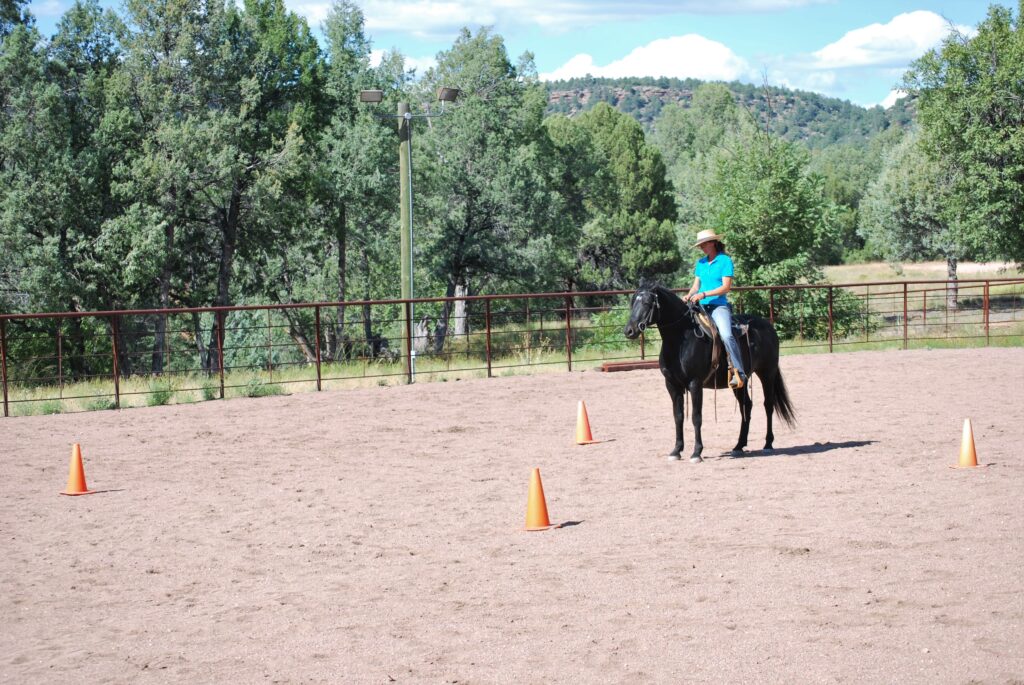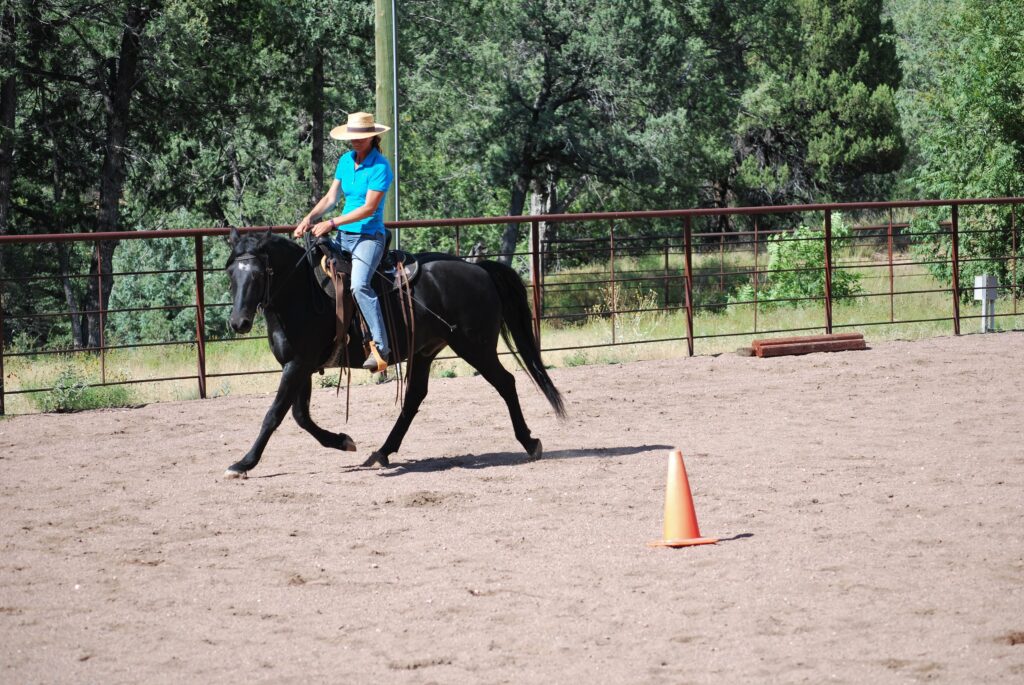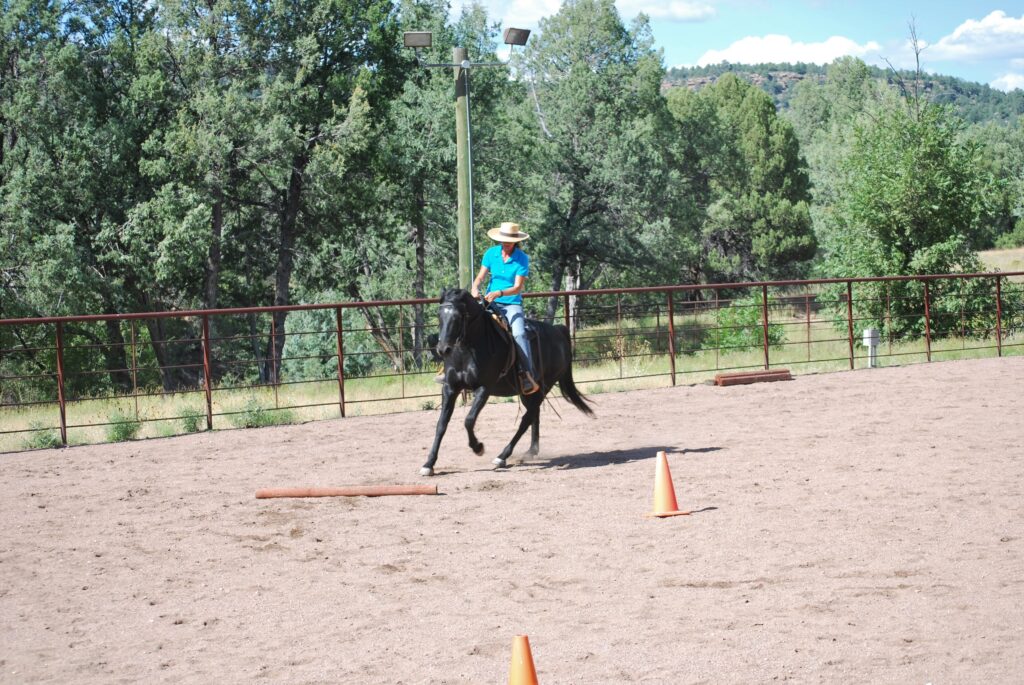Learning with your horse is a never-ending journey— except when it’s not. At some point, you might encounter difficulties that cause frustration for one or both of you. There could be a disconnect, a lack of focus or sheer boredom, among other issues.
How can you rekindle your horse’s love for learning and improve your communication with him? Trainer Tessa Nicolet of Payson, Arizona, has a suggestion: Balance playfulness and curiosity with focus and clarity while remaining creative in your approach.
Nicolet draws from a variety of experiences in both the English and Western disciplines. Her varied career spans from early lessons in Switzerland to colt-starting in Wyoming, to ventures in natural horsemanship and classical dressage. The result is what she calls a “cohesive” blend of techniques with an emphasis on equine behavior and creating a positive, confidence-building environment for horses.
Here, Nicolet shares her thoughts on the elements that contribute to a positive learning environment, common roadblocks and simple “best practices” to help your horse thrive.
Make It Playful
Before you start goal planning, Nicolet notes it’s important to meet your horse’s needs in three core areas. These are safety (which applies to you, as well); comfort (physical health and well-being); and movement (meaning giving your trainee ample opportunities to stay active).
Once these needs have been addressed, you can begin developing goals for yourself and your horse. Nicolet encourages focus on these seven core principles: an empathetic leader, master of body language, playful, curious enough to try new things, clear, focused and soft
Of these, Nicolet believes that the principle of playfulness should take an especially active role in the learning environment. “It’s out of play that horses will give you all that energy, all that beauty, all that willingness to work with you,” she explains. “So, we have to build an environment where play becomes really important.”
Play goes hand in hand with fun, and Nicolet finds that most horses learn better and are more willing to work with a partner when they are having fun. For example, we have all worked with our horses on maneuvers that can be difficult or boring—take, for example, transitions. As leaders, Nicolet believes we should try to find a way to make those moves fun to learn. If we don’t, she explains, our horses might start to protest and withdraw their participation.
The Role of Rider Error
If it feels like learning has stopped for you and your horse, make sure you aren’t the cause. While certain challenges are common and relatively easy to recognize, riders can also unknowingly sabotage their horses’ progress. Nicolet offers three examples of equine frustration that can develop from unintentional rider error:
The frustrated, playful horse: This horse, Nicolet says, is intelligent and playful. When being ridden, however, his rider discourages play. The rider might misunderstand the horse’s enthusiasm or not know how to effectively redirect it. Instead, the rider corrects the horse each time he shows his playful side, she comments. “That horse can be very frustrated, and either they shut down completely and stop being part of the conversation—or they can be kind of defiant,” Nicolet says.
The frustrated, confused horse: This horse’s frustration stems from inconsistencies in his rider’s aids. “If we as humans are not consistent in the way that we’re asking for things and teaching the horse what that response looks like, that horse can become very frustrated. Or they can become very fearful because they just don’t know the answer—ever,” Nicolet explains. Therefore, she stresses, it’s important for riders to be clear and purposeful with their body language.
The frustrated, bored horse: This horse drills day in and day out with no reward and no idea when the drills will stop. Nicolet points out that drilling is more helpful for humans than horses. “We need to drill to get the muscle memory, to understand what we’re doing. Horses don’t need it as much,” she says. So, while the horse might understand what the rider is asking, frustration sets in when the repetition of drill seems almost endless. This leads to boredom, giving up or acting out, Nicolet maintains.
Creating a positive physical environment
Where you work with your horse matters—and changing his physical environment can re-awaken an interest in learning. “Generally, I would say that changes in the physical environment that you’re working in can be really beneficial,” Nicolet says.
However, it’s important to note that new environments can sometimes produce fear or anxiety in a horse or rider, too. Therefore, Nicolet cautions riders to make sure they have the appropriate skills and knowledge to safely work with their horses in new areas. Do not put yourself or your horse in a dangerous situation.




patterns to keep them fresh. In this series, Nicolet introduces Ridge to a cloverleaf pattern at a walk, then rides it at a trot,
adds a pole and finally increases the gait to a canter. (Photos by Kayli Hanley)
In addition, Nicolet says, don’t forget to evaluate the footing in any new setting. Ask yourself: “Is the dirt too deep or the ground too hard?” After all, she explains, if the footing causes your horse pain, it will impede learning.
If you typically practice in an arena, there are two alternative locations Nicolet recommends visiting when you can safely do so: the trail and a show or competition. Here’s what those environments offer:
Trails
Leaves, trees and wildlife—trail riding brings a horse raw excitement that, when channeled properly, can be used to encourage learning.
Nicolet says she frequently works with one of her horses on the trail because his energy and willingness are plentiful in that location. If your horse has lost his desire to move in the arena, the open trail could be a great place to revive an interest in learning.
Shows
Competition can stimulate growth, but only if the pair’s focus is in the right place. Nicolet explains that in the show ring, sometimes riders project their stress onto their horses. She encourages riders to take a moment to breathe, relax and focus on what they know they can do versus what’s expected of them. “Focus on that partnership when you enter that ring, because it’s really about you and your horse,” Nicolet emphasizes.
If a rider’s mind is in the right place, a show can become a great learning environment, she adds. “I think competitions are very good at challenging us and giving us a plan and giving us something to work towards,” she says.
From the ground up
Riding isn’t the only activity that yields learning benefits. Groundwork, both traditional and at liberty, provides excellent opportunities for you to grow with your horse without mounting up.
Traditional groundwork
In this mode, riders can accomplish many tasks from the ground and pique their horse’s interest at the same time, Nicolet says. In addition leading and longeing, she explains that the switch from saddle to ground gives some exercises, like the transitions mentioned earlier, a new face.
Groundwork also offers an opportunity, she notes, to evaluate your horse before riding and to form a plan based on his behavior while ensuring that you are connecting to each other emotionally and mentally.
Another helpful tool to spice up the learning environment is liberty work on the ground. Nicolet defines “liberty work” as “any time that you are interacting with your horse and they don’t have a halter on, or they are free to respond however they want.”
Liberty
She adds that a specific space or activity is not necessarily required to practice liberty training. If your horse’s pen is large enough, an area like that can be a great place to start.
As Nicolet points out, liberty work can strengthen your partnership with your horse while allowing him to “voice” his thoughts.
Engaging your horse under saddle
To keep a horse engaged under saddle, it’s smart to make practice sessions both fun and fresh. “We’ve got to stay creative,” Nicolet emphasizes. “Be curious about trying new things.” To this end, she shares the following tips:
Incorporate a pattern: Not all of the maneuvers on which we work will interest our horses. If your horse seems bored with your current exercise, Nicolet suggests making it part of a larger pattern. For example, if you are working on backing up, consider adding a maneuver before and after the backup. This creates a simple pattern for your horse to work through.
Change up the pattern
Don’t limit yourself to a single pattern. Nicolet says that using different patterns in your riding sessions provides your horse with something new to explore. Examples include a cloverleaf, figure-eight or weaving in between poles.
Build on the pattern
A pattern doesn’t have to stay static. Nicolet points out that a rider can make a basic pattern something new by building on it. For example, if you start your session with a cloverleaf, here are some variations to consider:
• Make your circles the same size
• Maintain one tempo for the entire pattern
• hold consistent bend during the pattern
• Add transitions to the pattern
Add an obstacle. Navigating an obstacle such as a bridge, poles or gate is another great way to keep your horse engaged.
To use our earlier example, Nicolet suggests targeting an exercise that wouldn’t typically require an obstacle to practice: transitions. Makes transitions something new, by adding obstacles such as walkovers, for your horse to navigate pre- or post-transition. Keep in mind that the goal of adding obstacles is to give a horse purpose, Nicolet stresses.
So, there you have it: A sampling of the activities you can use to engage your horse while preserving a sense of “play” in your training sessions. As you build your own positive learning environment, Nicolet recommends choosing exercises that will grow your horse’s ability to relax, be balanced and willingly engage.
Don’t miss out! The free weekly EQUUS newsletter delivers the latest horse health information right to your in basket! If you’re not already receiving the EQUUS newsletter, click here to sign up. It’s *free*!








